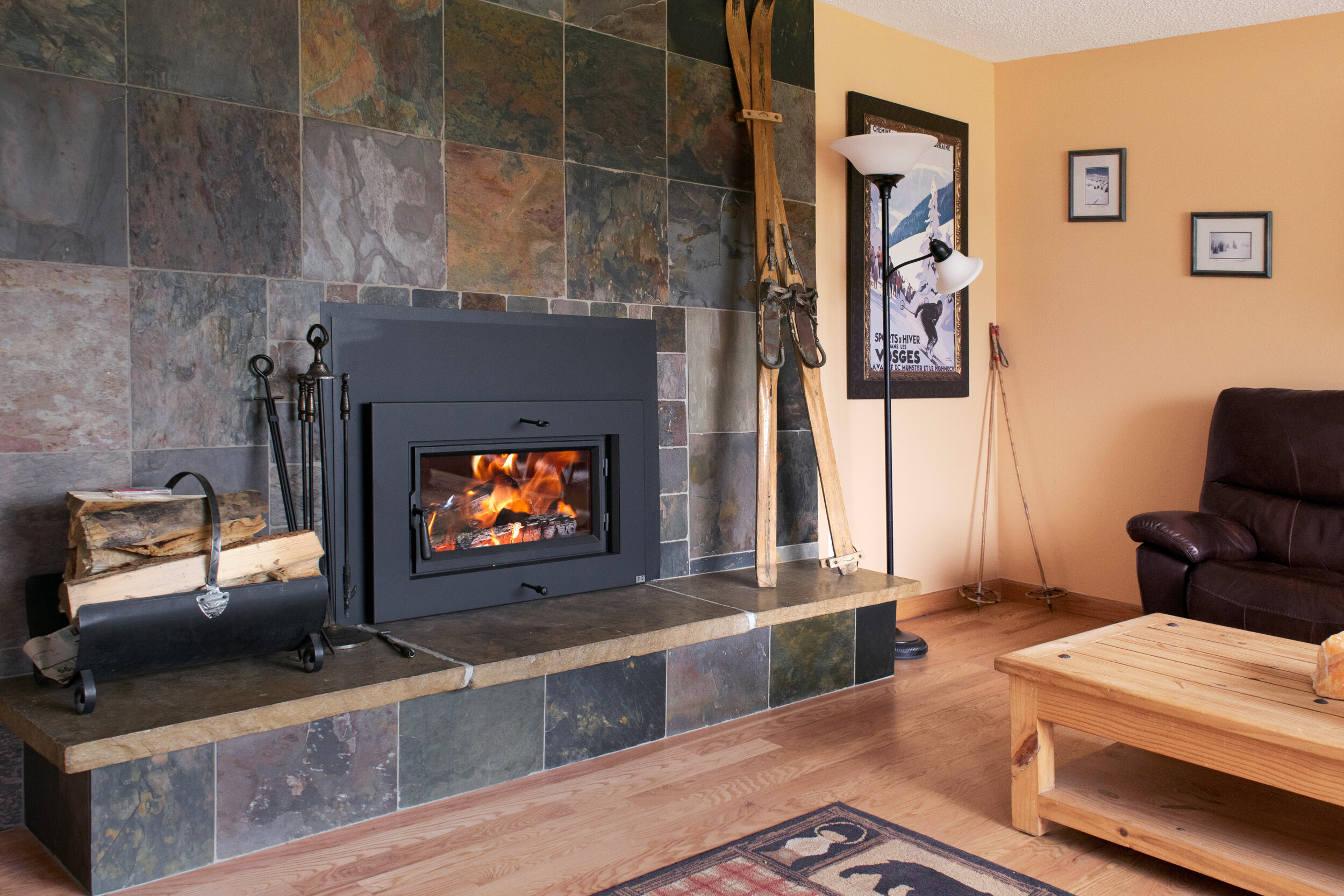At Mountain Hearth & Patio, customer safety comes first, that’s why we want to educate you on how to get the best performance out of your appliance. If you burn wood for heat, it’s important to use properly dried and seasoned wood to get the best efficiency from your fireplace. This is not just important for helping you burn less wood for more heat, it is also key to keeping creosote buildup in your chimney low. Creosote is an acidic, flammable byproduct of wood combustion that must be removed from your chimney yearly. If you’re burning poorly seasoned wood, creosote will build up more quickly and become hazardous before the burning season is even over.
Keeping your firewood dry and ready to burn is all in how you store it. Your wood should have a moisture content of 20% or less. Freshly cut wood can take a year or more to be fully seasoned. If you’re buying cord wood that is already seasoned, keeping it protected from the weather and off the ground in a good stack will ensure it stays dry and ready to burn.
Burning well seasoned wood in your fireplace, stove, or insert (such as the Fireplace Xtrordinair wood insert pictured here) ensures that your fire burns efficiently, with minimal creosote buildup.
How should I stack my firewood to keep it dry?
Here at Mountain Hearth & Patio, we’re often asked “what is the best way to store my firewood?” The key to keeping your firewood dry and ready to burn is a good stack. While there are many methods of stacking and storing firewood that vary by region and culture, the principles behind each of them are the same.
Keep your firewood elevated off the ground or on gravel for proper drainage. Moisture can also seep into the bottom layer of wood from the ground via capillary action.
Stack firewood with sufficient gaps for air to flow around each log.
Stack firewood with log ends exposed to the prevailing winds in your area.
Expose your firewood to sun.
Cover or stack wood in such a way that snow and rain slough off.
Do not stack your firewood against your house or other structure.
The holz hausen method of firewood stacking allows you to fit more wood in a smaller space. (Photo: Gerhard Elsner / CC BY-SA)
You can stack your firewood on a rack, held in place with posts, or you can make pillars out of cross stacked, split firewood logs on each end for maximum flexibility. There’s also the German “holz hausen” method of stacking firewood which stores more wood in a smaller space; however, in some cases, this method takes longer to stack and dry than the traditional American way we will cover here.
What is the traditional American method of stacking cord wood?
The traditional American firewood stack is based on building a shallow “wall” out of your firewood that stretches between two posts or pillars made of cross stacked, split cord wood. If you have a firewood rack, it operates based on the same principles but doesn’t require digging post holes or crafting pillars on either end. Here are a few tips for stacking in this way.
A good stack of cord wood starts with logs cut to a similar length, traditionally 16”.
Make sure that you have either pallets, pressure treated 2x4’s, a firewood rack, or gravel under your firewood to keep your wood elevated off the ground and protected from moisture.
Place your posts or construct your end pillars once your base is in place.
Be mindful of how you stack wood so that each piece fits nicely, the ends are even, and there are sufficient air gaps around each log to allow for drying.
Traditionally, 16” split logs are stacked to about 4’ high, don’t stack much more than 5’ high without good support, as your stack may become unstable.
Cover your wood either in a wood shed with the cut ends of the logs open to the prevailing winds or with a tarp that covers the top but not the cut ends of the stack.
If you follow these tips, you should get a nice-looking stack of firewood that keeps your fuel dry, and ready to burn. If you’re stacking freshly cut wood, remember that you will not be able to burn it for a year or more. When you buy ready to burn, pre-seasoned wood, you don’t have to worry about that, but firewood should still be stacked in this way to keep it dry and elevated off the ground.
Your firewood stack must be elevated of the ground to prevent moisture from infiltrating the pile.
How do I know if my firewood is ready to use in my fireplace?
There are a couple ways to tell if your firewood is properly seasoned, dry, and ready to burn. You can determine the moisture content of your wood with or without a moisture meter.
Without a moisture meter:
Check the ends of the logs, dry and seasoned wood will be cracked and darker on the ends.
Make sure you can’t see any green in the wood.
You should be able to easily peel the bark.
Seasoned wood is lighter in weight than wet wood.
If your firewood meets these criteria, you should do one more test for proper seasoning. Take two split pieces of your cord wood and firmly tap them together. You should hear a hollow, slightly ringing, sound. If you hear a thud or thunk, your wood is not properly seasoned.
With a moisture meter:
Using moisture meter will ensure that the wood you burn is well seasoned and ready for you to burn. (Photo: Ralph Pfeifer, CC-BY 4.0)
The easiest way to determine the readiness of your firewood is with a moisture meter. You can pick up a moisture meter at any hardware store or on Amazon for about $30. If you have a moisture meter:
Pick a log that meets the visual criteria above.
Split the log.
Test the newly split side, pushing the contacts on the meter firmly into the wood, parallel to the grain.
When testing with a moisture meter, it’s best to test at 50-90 °F (ca. 10-32 °C) because lower temperature wood will read as having lower moisture with commonly available consumer meters. However, if this isn’t possible, you can follow a correction table to find an accurate reading at a lower temperature.
What should I do to keep my hearth appliance safe when the burning season is over?
When you’re done burning for the year, it’s time to have your chimney swept and inspected by a certified chimney sweep. Over the course of the burning season, creosote builds up in your chimney. No matter how seasoned your wood is, this annual service ensures safe and efficient operation of your fireplace.
Annual fireplace service by a professional, certified chimney sweep ensures that your fires keep burning safely and efficiently.
Creosote is a flammable, toxic, and acidic substance that is a byproduct of combustion. Even in today’s hyper-efficient fireplaces, stoves, and inserts, creosote buildup can get out of hand if left untended. This buildup is the leading cause of hostile chimney fires and is a hazard to the health and safety of your family.
Mountain Hearth & Patio has CSIA-Certified chimney sweeps on staff who can perform your annual chimney sweeping and inspection to keep you burning safely for years to come. If you need qualified, certified, and experienced fireplace and chimney maintenance or repair, call us at (303) 679-1601 to set up your appointment, drop us a line by email at Office@MtnHP.com or reach us through our website. If you want to update your existing fireplace to a modern, efficient hearth appliance we can help with that too!








